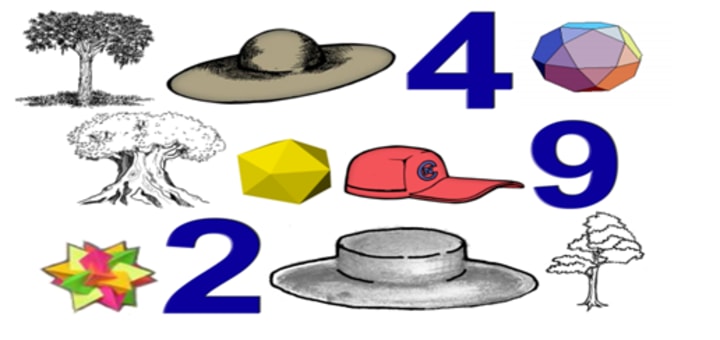Lesson Planning: Sets: An Introduction
Detailed lesson plan in mathematics with the topic Sets: An Introduction

Lesson Plan Information
- Subject/Course: Mathematics
- Grade Level: Grade 7
- Topic: SETS: An Introduction
- Length of Period: 50 minutes
- Facilitator:
- Date/Time:
General Objective(s):
In this lesson, student's are expected to:
1. Describe and illustrate.
a) well-defined sets;
b) subsets;
c) universal set, and;
d) the null set.
2. Use Venn Diagrams to represent sets and subsets.
1. Lesson Section - Introduction
A set is a collection of objects that have something in common or follow a rule. The objects in the set are called its elements. Set notation uses curly braces, with elements separated by commas.
This is an introductory lesson on sets. A clear understanding of the concepts in this lesson will help you easily grasp number properties and enable you to quickly identify multiple solutions involving sets of numbers.
Activities - Teacher's Activities
- The teacher will discuss the introduction of the subjects in the detailed time length.
- The teacher will ask a question(s) at the end of the discussion.
Activities - Students Activities
- Students must listen attentively and answer the question raised by the teacher.
Learning Materials
- Overhead Projector (PowerPoint presentation)
Time
5 minutes
2. Lesson Section - Review
Vocabulary Quiz for Introduction (10 items)
Activities - Teacher's Activities
- The teacher will ask the students to jot down the words they remember during the discussion of the introduction.
- The teacher will introduce the Activity Paper to be used.
Activities - Students Activities
- Students will start writing ten (10) items of word from the introduction, as discussed by the teacher.
Learning Materials
- Activity Paper (teacher will provide a copy of the activity paper to the students) (Student Worksheet) .
- Note: Activity Paper can be downloaded on the link I provided below.
Time
3 minutes
3. Lesson Section - Icebreaker
People Search
- (Note: People Search is an active learning strategies) . Can be downloaded with the link I provided below.
Activities - Teacher's Activities
- Distribute a copy of the People Search to each student and explain the rules.
- At the end of 5 minutes, ask for volunteers to share some of the responses they recorded.
Activities - Students Activities
- Use the blank People Search to create a scavenger hunt.
- Complete the statements in each square to provide the clues.
- In 5 minutes, students must obtain a signature for as many of the squares as possible.
- Students must first introduce themselves to their classmates before asking for correct answers.
- Students may use the signature of each student only once.
- When students have obtained a signature for every square, they should return to their seats.
Learning Materials
- Copies of People Search
Time
4 minutes
4. Lesson Section - Activity

Activities - Teacher's Activities
- Show the below objects.
- Ask the students to group the objects accordingly and label each group.
Activities - Students Activities
- Students to group objects accordingly and label each group using the Activity Paper.
Learning Materials
- Overhead Projector (PowerPoint presentation)
- Activity Paper (Student Worksheet)
Time
1 minute
5. Lesson Section - Reading and Discussion
Reading and Discussion
Activities - Teacher's Activities
- The teacher will ask the following three (3) questions:
a. How many groups are there?
b. Does each object belong to a group?
c. Is there an object that belongs to more than one group? Which one?
- The teacher will discuss the following:
The groups are called sets for as long as the objects in the group share a characteristic and are thus, well defined.
Problem:
Consider the set consisting of whole numbers from 1 to 200. Let this be set U. Form smaller sets consisting of elements of U that share a different characteristic. For example, let E be the set of all even numbers from 1 to 200.
1. Can you form three more such sets?
2. How many elements are there in each of these sets?
3. Do any of these sets have any elements in common?
4. Did you think of a set with no element?
Important Terms to Remember
The following are terms that you must remember from this point on.
A set is a well-defined group of objects, called elements that share a common characteristic. For example, 3 of the objects above belong to the set of head covering or simply hats (ladies’ hat, baseball cap, hard hat).
The set F is a subset of set A if all elements of F are also elements of A. For example, the even numbers 2, 4 and 12 all belong to the set of whole numbers. Therefore, the even numbers 2, 4, and 12 form a subset of the set of whole numbers. F is a proper subset of A if F does not contain all elements of A.
The universal set U is the set that contains all objects under consideration.
The null set ø is an empty set. The null set is a subset of any set.
The cardinality of a set A is the number of elements contained in A.
Notations and Symbols
In this section, you will learn some of the notations and symbols pertaining to sets.
Uppercase letters will be used to name sets and lowercase letters will be used to refer to any element of a set. For example, let H be the set of all objects on page 1 that cover or protect the head. We write
H = {ladies’ hat, baseball cap, hard hat}
This is the listing or roster method of naming the elements of a set.
Another way of writing the elements of a set is with the use of a descriptor. This is the rule method. For example, H = {x| x covers and protects the head}.
This is read as “the set H contains the element x such that x covers and protects the head.”
The symbol ø or { } will be used to refer to an empty set.
If F is a subset of A, then we write FA. We also say that A contains the set F and write it as AF. If F is a proper subset of A, then we write FA.
The cardinality of a set A is written as n(A).
Activities - Students Activities
- Students must listen attentively to the teacher.
- Jot down important details and start answering the three (3) questions raised by the teacher.
Note: The answer will be discussed after the reading and discussion.
Learning Materials
- Overhead Projector (PowerPoint presentation)
- Activity Paper (Student Worksheet)
Time
10 minutes
6. Lesson Section - Questions to Ponder (Post-Activity Discussion)
Activities - Teacher's Activities
- The teacher will ask the question and again posed in the opening activity.
- The teacher will ask volunteers to get their answers to the question.
1. How many sets are there?
There is the set of headcovers (hats), the set of trees, the set of even numbers, and the set of polyhedra. But there is also a set of round objects and a set of pointy objects. There are 6 well-defined sets.
2. Does each object belong to a set?
Yes.
3. Is there an object that belongs to more than one set? Which ones?
All the hats belong to the set of round objects. The pine trees and two of the polyhedra belong to the set of pointy objects.
Activities - Students Activities
- The student must give their answers to the raised questions.
Learning Materials
- Overhead Projector (PowerPoint presentation)
- Activity Paper (Student Worksheet)
Time
5 minutes
7. Lesson Section - Exercises
Activities - Teacher's Activities
- Teacher will ask the students to do the following:
Do the following exercises.
1. Give 3 examples of well-defined sets.
2. Name two subsets of the set of whole numbers using both the listing method and the rule method.
3. Let B = [1, 3, 5, 7, 9}. List all the possible subsets of B.
4. Answer this question: How many subsets does a set of n elements have?
Activities - Students Activities
- Student must answer the exercises.
Learning Materials
- Overhead Projector (PowerPoint presentation)
- Activity Paper (Student Worksheet)
Time
5 minutes
8. Lesson Section - Venn Diagrams

Activities - Teacher's Activities
- The teacher will introduce the following:
- Sets and subsets may be represented using Venn Diagrams. These are diagrams that make use of geometric shapes to show relationships between sets.
- Consider the Venn diagram below. Let the universal set U be all the elements in sets A, B, C and D.
- Each shape represents a set. Note that although there are no elements shown inside each shape, we can surmise how the sets are related to each other. Notice that set B is inside set A. This indicates that all elements in B are contained in A. The same with set C. Set D, however, is separate from A, B, C. What does it mean?
Activities - Students Activities
- Students must listen attentively to the teacher.
- Jot down important details and answer the question raised by the teacher.
Learning Materials
- Overhead Projector (PowerPoint presentation)
- Activity Paper (Student Worksheet)
Time
4 minutes
9. Lesson Section - Exercises
Activities - Teacher's Activities
- Teacher will ask the students the following:
Draw a Venn diagram to show the relationships between the following pairs or groups of sets:
1. E = {2, 4, 8, 16, 32}
F = {2, 32}
2. V is the set of all odd numbers
W = {5, 15, 25, 35, 45, 55,….}
3. R = {x| x is a factor of 24}
S = { }
T = {7, 9, 11}
Activities - Students Activities
- Student must answer the following exercises .
Learning Materials
- Overhead Projector (PowerPoint presentation)
- Activity Paper (Student Worksheet)
Time
5 minutes
10. Lesson Section - Assessment/Reflection
Lead-ins
- (Note: Lead-ins is an active learning strategies)
Activities - Teacher's Activities
The teacher will: (refer to the Use of Active Learning Strategies)
1. Write a lead-in statement on the board or overhead, such as:
• Today, I learned . . .
• In this lesson, I discovered . . .
• In this lesson, I was pleased that I . . .
• In this task, I found it easy (difficult) to . . .
• The most important thing I learned in this class was . . .
2. Let students know that they will have the chance to use the lead-ins as a way of reflecting about how and what they learned in a lesson or unit.
3. Share an example of completed reflection. Explain that this is an open-minded reflection without a correct answer. All that is needed is an honest response. Let students know before they begin to write whether or not the reflection will be collected. As students become more comfortable with the process, they may take more time and may write lengthier reflections.
Activities - Students Activities
- Student must:
- Students will use the lead-ins as a way of reflecting on how and what they learned in a lesson.
- Arrange students in a small group and use lead-in statements as discussion starters.
Learning Materials
- Overhead Projector (PowerPoint presentation)
- Activity Paper (Student Worksheet)
Time
10 minutes
Copy of the detailed lesson plan in mathematics with the topic Sets: An Introduction can be downloaded with the below link. You are free to modify based on your preference.
PDF File:
Excel File:
Like what you read?
Don't forget to please like my story.
Thank you.
About the Creator
Domingo Añasco-Gaces Samontina, Jr.
.Professional Member of the Mechatronics and Robotics Society of the Philippines
.Certified Documented Information Controller with TUV Rheinland Qualifications
.Master of Science in Engineering (on-going) with Professional Teacher Certificate






Comments
There are no comments for this story
Be the first to respond and start the conversation.